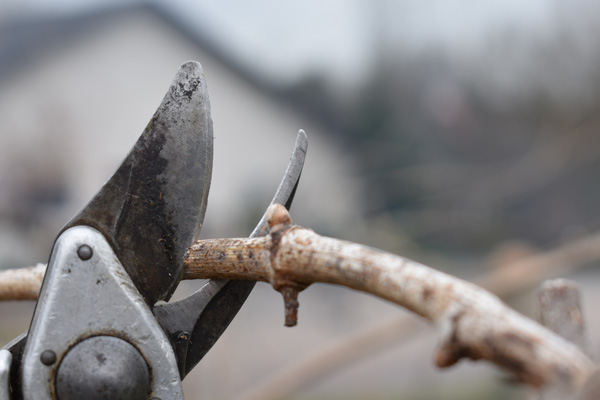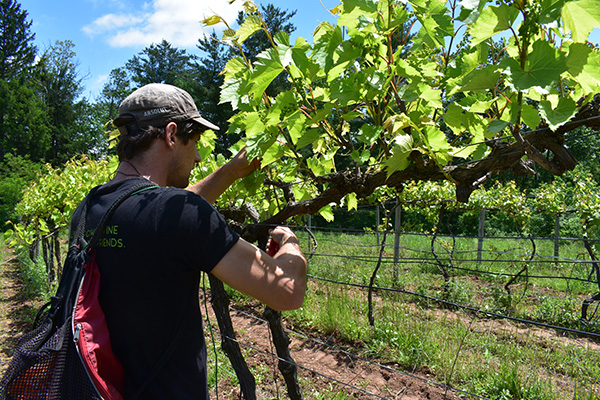The Vineyard/Winery
The Vineyard | The Winery
The Vineyard
Climate | Soil | Sustainability | Planting | Training | Disease Control | Harvest
We are the oldest and largest vineyard in the Pocono Mountains. And while we’re bragging, we might as well mention that we have the healthiest vineyard soil of all 600 tested in the US. Also, we think Dom looks very handsome in his overalls. (Okay, we promise we’re done.)
Both in farming and providing an atmosphere for customers, we strive to respect the peacefulness of the nature around us.
Climate

We genuflect deepest to climate. Particularly, the lowest temperature of the coldest month, in conjunction with the length of time between the last spring frost and the first fall frost. These numbers tell us what variety of grape we can grow and ripen in a normal year. Sounds easy. But the siren sings, and we rationalize growing an ill-fitting variety simply because of its eminence.
Back in the pre-internet 80’s, we planted what we liked to drink. We just drew a line of latitude around the globe and voilà! This is the Procrustean Bed of viticulture: trying to make a variety fit a climate, a square peg in a round hole.
Big Creek has a continental climate with warm, humid summers, cold winters, and lots of variation in between. “Average” is a particularly useless bit of statistic where our weather is concerned. The predominant winds are from the north and west, with no large bodies of water (oceans, big lakes, very big rivers) to moderate temperature, particularly killing frost. Rain and snow are distributed evenly throughout the year. (At least the books say so.)
Soil

Drainage and the inherent fertility of the soil have a big impact on how we develop the vineyard and how we best take advantage to produce a suitable wine. “Channery-silt -loam” is how our soils are described by soil people. Like an ingredient list on prepackaged food, the first “ingredient” is the most abundant. In our case it is channers-course fragments of shale, sandstone, and slate. The percentage of rock fragments can run from 12% to 80%.
This high percentage of roughage and just a little clay result in soils which are terrible at holding water. Coupled with the fact that the water table occurs below the bedrock, it means the only water that our grapes receive is rain, and that does not stay around too long. Historically, farmers in our area consider 10 days without rain as drought. So, we really do not worry too much about rain, which is unusual for a continental vineyard.
Fertility (or inherent vigor of the soil) comes into play if there is a combination of both high nitrogen and ample water available. Here we catch a break, we have a low percentage of organics, low CEC (Cation Exchange Capacity- ability of soil to hold ammonium, calcium, magnesium, and potassium ions) with little available water.
Sustainability
Wee things we can’t see also impact the great biologic web of our vineyard. One measure of the health of this system is the abundance and diversity of microbes (bacteria, fungi, etc.) inhabiting our soils. A conservative approach to amending the soils, letting our native vegetation thrive (weeds) and the abilities of the previous farmers in husbanding the fields have resulted in our vineyard being recognized as among the most diverse in the United States:
To: Big Creek Vineyard (bigcreek@ptd.net)
I would like to inform you that we are going to launch a biodiversity ranking worldwide and one of the vineyards of your winery that we have analyzed with our WineSeq technology in the last two years has been selected in the TOP 5 of biological diversity in USA.
This ranking, based on the study of the biodiversity level from more than 600 vineyards, highlights and enhances the plots that register an extraordinary microbiological diversity. This fact, that refers to the microbial diversity present in vineyard soils, is one of the indicators of their sustainability. In order to establish this ranking, biodiversity indexes have been applied, traditionally used in ecology and other related sciences.
The role that certain microbial species play in maintaining the health status of vineyards, as well as the soil fertility, vine efficiency and aromatic properties of wines from a certain region, is well-known. However, this ranking measures the global complexity of those microbial communities as a future guarantee for vineyards, possibly following the respect for terroir and the implementation of good practices in the vineyard.
– Ruben G. Franco
Biome Makers’ Marketing Manager
Read the article here:
Forbes: Biotechnology Company Biome Makers Recognizes Top 10 U.S. Terroirs
It is a wonderfully academic puzzle we have.
Also, we had a good laugh seeing that list full of famous California wineries with Kunkletown, PA right at the top. “What’s a kunkle?” we imagined people wondering in vague horror.
Planting

Our rows are laid parallel to the slope to minimize erosion. Trying to get a row straight on ground that slopes both north to south and from side to side is not easy. But they seem to get a little straighter with the passing years.
Training
Right now our vines are trained to a moderately high cordon. This keeps labor manageable while ensuring that the clusters get the right amount of sun.


Disease Control
As a staunch non-ideologue I always use what I consider appropriate to the vintage. Labels like organic and sustainable are wonderful but are not always the best choice for the vineyard or the guy doing the spraying (that would be me).
Check out this video we made about a trunk disease that impacted some of our vines, and how we chose to handle it:
Harvest
Harvest is usually in September, and such a peaceful affair. The butterflies and bees like to drink the juice and peacefully accompany us. “I’ve never been stung once in 15 years,” says our manager Carrie.
The Winery
Winery | Crushing | Pressing | Bottling | Sales

The building is a hybrid between a Pennsylvania Dutch bank barn and a Mediterranean farm house. Our open floorplan features a tasting room overlooking the work area. If we are doing wine things, people can watch from the comfort of the mezzanine.

This video of Grandma Millie transporting boxes downstairs offers a good view of our interior, including the red stone floors and vaulted ceiling. Flawless technique.
The building itself was designed by our vintner Dominic. Construction was completed in 1992.
People often ask if this used to be a church. It wasn’t, but there was a church who liked the design so much they asked Dominic for the blueprints.
“Sure,” he said. So maybe folks should be asking churches if they were ever a winery.
This story concluded in the funniest possible way when we decided to look the church up and perhaps pay a visit, only to discover they had converted it into a Jesus-themed pizza place. We did indeed try the pizza, and it was great. (It kind of has to be with that level of endorsement.) It’s called Belltower Pizza and it’s not too far from our vineyard, and worth the stop if you’re visiting Country Junction.



To learn more about the history of the property, check out Our History.
Crushing
The first step in winemaking is, usually, to remove the grapes from the stems and crush them gently. We use an old German machine called a Wottle. A simple, sturdy machine that is easy to clean. (video) red grapes will be fermented on their skins while white variteits will most often get pressed prior to fermentation.
Pressing
The theme of gentle handling continues with the next step. Here again we use an old German machine made by Wilmes. Simple, gentle and pretty easy to clean.
The machine featured in the videos below is filled with grapes. A bladder fills with water to crush the grapes to remove the juice. Once it’s finished, there’s a giant blob of pressed grapes left behind, which is always fun to watch deflate when you empty the bladder:
This press is very easy to empty. We dump the grape husks onto a tarp and use them for composting.
Bottling
After an appropriate time our wines are bottled using… wait for it….. an old German machine made by Seitz. Simple and easy to clean.
Sales

All our wines are sold directly at the winery. We also ship within the U.S., just give us a call at 610-381-3959.



